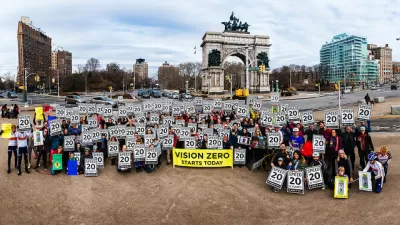Traffic fatalities are on pace to reach 35,000 in the United States this year. Some advocates are saying it's time for traffic engineers to stop blaming the victims.
"US traffic deaths are rising again—fatalities jumped 8.1 percent in the first half of 2015, National Highway Traffic Safety Administration (NHTSA) reports," according to an article by Robert Steuteville.
Steuteville notes that the NHTSA cites "drunken, drugged, distracted and drowsy driving; speeding; and failure to use safety features such as seat belts and child seats," for the increase in tragedy, but he wishes they'd acknowledge another D—the "design of streets and communities." When it comes to design, argues Steuteville, the "bigger is better" approach always wins out—even when all evidence suggests that smaller lanes reduce risks.
"The NHTSA reaction to the current trend in fatalities shows that evidence continues to be ignored. Not everywhere: In the alphabet soup of agencies that govern streets and highways, the Federal Highway Administration (FHWA) recently admitted that wider lanes have no safety benefit on thoroughfares designed for less than 50 mph. This is a small step in the right direction, given that wider lanes degrade safety in urban conditions. It is time for transportation engineers to look in the mirror, own up to the damage done to people and communities, and disavow once and for all the 'bigger is better' approach to urban thoroughfares."
The article surveys some of the influential studies that make the case for a design solutions that could start reducing the loss of life on U.S. streets, roads, and highways before arriving to that frank conclusion. Of particular interest in the definitive 2008 study by Garrick and Marshall, which found that newer cities in California laid out with wider streets and longer blocks have three times more traffic fatalities per capita than cities built before 1950.
That Garrick and Marshall study was also of particular interest to Angie Schmitt at Streetsblog, who deserves a hat tip for sharing this article.
FULL STORY: As traffic deaths rise, blame engineering dogma

Maui's Vacation Rental Debate Turns Ugly
Verbal attacks, misinformation campaigns and fistfights plague a high-stakes debate to convert thousands of vacation rentals into long-term housing.

Planetizen Federal Action Tracker
A weekly monitor of how Trump’s orders and actions are impacting planners and planning in America.

San Francisco Suspends Traffic Calming Amidst Record Deaths
Citing “a challenging fiscal landscape,” the city will cease the program on the heels of 42 traffic deaths, including 24 pedestrians.

Defunct Pittsburgh Power Plant to Become Residential Tower
A decommissioned steam heat plant will be redeveloped into almost 100 affordable housing units.

Trump Prompts Restructuring of Transportation Research Board in “Unprecedented Overreach”
The TRB has eliminated more than half of its committees including those focused on climate, equity, and cities.

Amtrak Rolls Out New Orleans to Alabama “Mardi Gras” Train
The new service will operate morning and evening departures between Mobile and New Orleans.
Urban Design for Planners 1: Software Tools
This six-course series explores essential urban design concepts using open source software and equips planners with the tools they need to participate fully in the urban design process.
Planning for Universal Design
Learn the tools for implementing Universal Design in planning regulations.
Heyer Gruel & Associates PA
JM Goldson LLC
Custer County Colorado
City of Camden Redevelopment Agency
City of Astoria
Transportation Research & Education Center (TREC) at Portland State University
Jefferson Parish Government
Camden Redevelopment Agency
City of Claremont





























